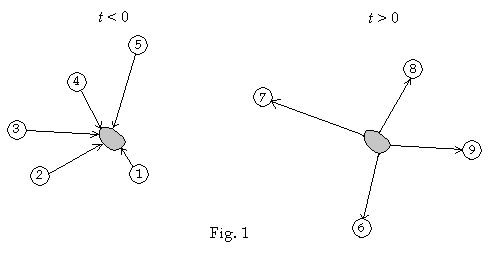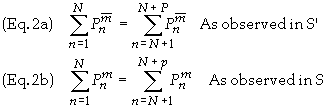Conservation
of Mass
Back
to Physics World
Back to Special Relativity
The
4-momentum, P, of a particle is defined in terms of the particle’s
proper mass, m0,
and its 4-velocity, U
º dX/dt º
(cg,
gv)
where
g º
dt/dt,
as
![]()
m
= gm0
is the particle’s inertial mass and p
is the particle’s 3-momentum. Note that according to this P0
º
mc. Postulate that 3-momentum is conserved in all inertial frames of
reference. Let there be a system of N particles going into a collision
and P particles coming out of that collision. Let us also assume that the
particles interact only within a small region of space and be non-interacting
otherwise. Let the N particles going into the reaction be labeled 1, 2,
3, …, N and the P particles coming out of the reaction labeled N+1,
N+2, … , N+P See Figure 1 below for the case N= 5
and P = 4. The shaded portion in the diagram is the only region of space
where the particles interact significantly.

Let
frame S and S’ be in standard configuration where S’ is moving in the +x
direction relative to S. In the notation above the expression for the
conservation of each component of a particle’s linear 3-momentum is

If we
substitute the Lorentz transformation, given by (Note that Einstein’s
summation convention is employed here).
![]()
into Eq.
(2a) we obtain

Expanding
both sides we get

Eq. (5)
can be expanded further to yield

Rearranging
terms and using the identity
![]() we obtain
we obtain

The
right hand side of Eq. (7) vanishes according to Eq. (2b). Since this
relationship must hold for all Lorentz transformations then this implies
that the term within the parentheses on the left hand since must vanish giving

The right side of Eq. (8)
is simply the expression for conservation of mass. Thus it is shown when the
Lorentz transformation is applied to the 4-momentum and the conservation of
3-momentum is assumed to be valid in all inertial frames of reference then it
follows that mass is a conserved quantity.
Back
to Physics World
Back to Special Relativity